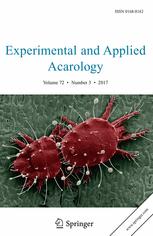Ver ítem
- xmlui.general.dspace_homeCentros Regionales y EEAsCentro Regional Santa FeEEA RafaelaArtículos científicosxmlui.ArtifactBrowser.ItemViewer.trail
- Inicio
- Centros Regionales y EEAs
- Centro Regional Santa Fe
- EEA Rafaela
- Artículos científicos
- Ver ítem
Bacteria of the genera Ehrlichia and Rickettsia in ticks of the family Ixodidae with medical importance in Argentina
Resumen
The aim of this study was to get an overview about the occurrence of bacteria from the genus Ehrlichia and Rickettsia in ixodid ticks with medical importance in Argentina. Therefore, in 2013 and 2014, free-living ticks were collected in different provinces of northern Argentina. These ticks were determined as Amblyomma sculptum, Amblyomma neumanni, Amblyomma parvum, Amblyomma triste, Amblyomma ovale, Amblyomma tonelliae and Haemaphysalis juxtakochi. All
[ver mas...]
The aim of this study was to get an overview about the occurrence of bacteria from the genus Ehrlichia and Rickettsia in ixodid ticks with medical importance in Argentina. Therefore, in 2013 and 2014, free-living ticks were collected in different provinces of northern Argentina. These ticks were determined as Amblyomma sculptum, Amblyomma neumanni, Amblyomma parvum, Amblyomma triste, Amblyomma ovale, Amblyomma tonelliae and Haemaphysalis juxtakochi. All samples were tested to determine the infection with Ehrlichia spp. and Rickettsia spp. by PCR assays. Rickettsial DNA was detected in all tested tick species, with the exception of A. tonelliae. ‘Candidatus Rickettsia amblyommii’, ‘Candidatus Rickettsia andeanae’, and Rickettsia parkeri were found in A. neumanni, A. parvum, and A. triste, respectively. Another rickettsial species, Rickettsia bellii, was found in A. sculptum, A. ovale and H. juxtakochi. None of the tested ticks showed infection with Ehrlichia. The results of the study demonstrate that Rickettsia species belonging to the spotted fever group are associated with various species of Amblyomma throughout a wide area of northern Argentina, where cases of Amblyomma ticks biting humans are common.
[Cerrar]

Fuente
Experimental and applied acarology 71 (1) : 87–96. (2016)
Fecha
2016
ISSN
0168-8162 (Print)
1572-9702 (Online)
1572-9702 (Online)
Formato
pdf
Tipo de documento
article
Palabras Claves
Derechos de acceso
Restringido
 Excepto donde se diga explicitamente, este item se publica bajo la siguiente descripción: Creative Commons Attribution-NonCommercial-ShareAlike 2.5 Unported (CC BY-NC-SA 2.5)
Excepto donde se diga explicitamente, este item se publica bajo la siguiente descripción: Creative Commons Attribution-NonCommercial-ShareAlike 2.5 Unported (CC BY-NC-SA 2.5)

